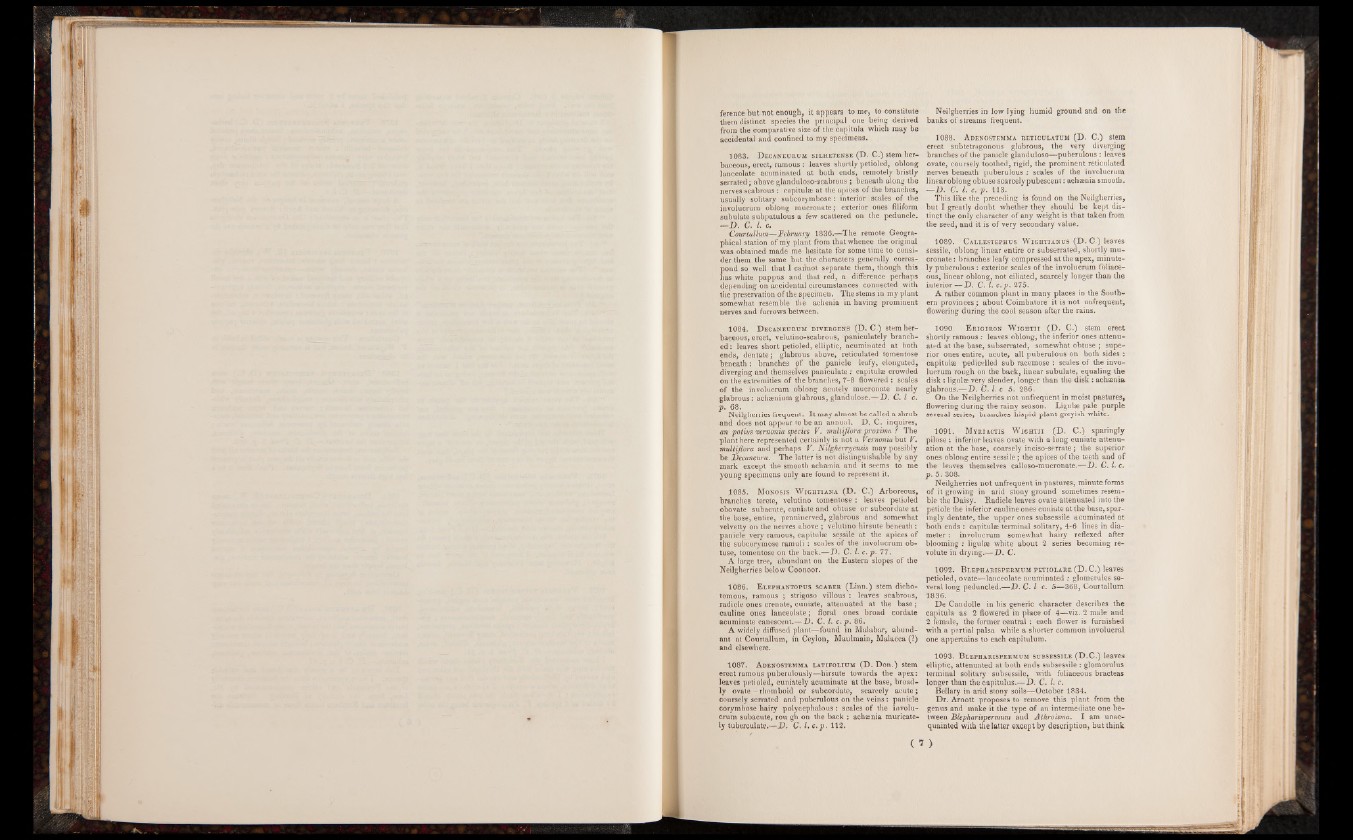
ference but not enough, it appears to me, to constitute
them distinct species the principal one being derived
from the comparative size of the capitula which may be
accidental and confined to my specimens.
1083. D ecaneurum silhetense (D. C.) stem herbaceous,
erect, ramous: leaves shortly petioled, oblong
lanceolate acuminated at both ends, remotely bristly
serrated; above glanduloso-scabrous; beneath along the
nerves scabrous : capitula; at the apices of the branches,
usually solitary subcorymbose : interior scales of the
involucrum oblong mucronate; exterior ones filiform
subulate subpatulous a few scattered on the peduncle.
—D. C. 1. c.
Courtallum—February 1836.—The remote Geographical
station of my plant from that whence the original
was obtained made me hesitate for some time to consider
them the same but the characters generally correspond
so well that I cannot separate them, though this
has white pappus and that red, a difference perhaps
depending on accidental circumstances connected with
the preservation of the specimen. The stems in my plant
somewhat resemble the achenia in having prominent
nerves and furrows between.
1084. D ecaneurum divergen.s (D. C.) stem herbaceous,
erect, velutino-scabrous, 'paniculately branched
: leaves short petioled, elliptic, acuminated at both
ends, dentate; glabrous above, reticulated tomentose
beneath: branches of the panicle leafy, elongated,
diverging and themselves paniculate; capitulae crowded
on the extremities of the branches, 7-8 flowered : scales
of the involucrum oblong acutely mucronate nearly
glabrous: achaenium glabrous, glandulose.—D. C. I c.
p. 68.
Neilgherries frequent. It may almost be called a shrub
and does not appear to be an annual. D. C. inquires,
an potius vemonia species V. multijlora proxima ? The
plant here represented certainly is not a Vemonia but V.
multijlora and perhaps V. Nilgherryensis may possibly
be Decaneura. The latter is not distinguishable by any
mark except the smooth achaenia and it seems to me
young specimens only are found to represent it.
1085. Monosis Wightiana (D. C.) Arboreous,
branches terete, velutino tomentose : leaves petioled
obovate subacute, cuniate and obtuse or subcordate at
the base, entire, penninerved, glabrous and somewhat
velvetty on the nerves above ; velutino hirsute beneath :
panicle very ramous, capitulae sessile at the apices of
the subcorymose ramuli : scales of the involucrum obtuse,
tomentose on the back.—D. C. 1. c.p. 77.
A large tree, abundant on the Eastern slopes of the
Neilgherries below Coonoor.
1086. Elephantopus scaber (Linn.) stem dichotomous,
ramous ; strigoso villous : leaves scabrous,
radicle ones crenate, cuniate, attenuated at the base;
cauline ones lanceolate; floral ones broad cordate
acuminate canescent.—I). C. 1. c. p. 86.
A widely diffused plant—found in Malabar, abundant
at Courtallum, in Ceylon, Maulmain, Malacca (?)
and elsewhere.
1087. Adenostemma latifolium (D. Don.) stem
erect ramous puberulously—hirsute towards the apex:
leaves petioled, cuni&tely acuminate at the base, broadly
ovate - rhomboid or subcordate, scarcely acute;
coursely serrated and puberulous on the veins: panicle
corymbose hairy polycephalous : scales of the involucrum
subacute, rou gh on the back : achaenia muricate-
ly tuberculate.—D. C. 1. c.p. 112.
Neilgherries in low lying humid ground and on the
banks of streams frequent.
1088. Adenostemma reticulatum (D. C.) stem
erect subtetragonous glabrous, the very diverging
branches of the panicle glanduloso—puberulous : leaves
ovate, coursely toothed, rigid, the prominent reticulated
nerves beneath puberulous : scales of the involucrum
linear oblong obtuse scarcely pubescent: achaenia smooth.
—D. C. 1. c. p. 113.
This like the preceding is found on the Neilgherries,
but I greatly doubt whether they should be kept distinct
the only character of any weight is that taken from
the seed, and it is of very secondary value.
1089. Callestephus Wightianus (D. C.) leaves
sessile, oblong linear entire or subserrated, shortly mucronate
: branches leafy compressed at the apex, minutely
puberulous: exterior scales of the involucrum foliace-
ous, linear oblong, not ciliated, scarcely longer than the
interior—D. C. 1. c.p. 275.
A rather common plant in many places in the Southern
provinces; about Coimbatore it is not unfrequent,
flowering during the cool season after the rains.
1090. E rigiron Wightii (D. C.) stem erect
shortly ramous: leaves oblong, the inferior ones attenuated
at the base, subserrated, somewhat obtuse ; superior
ones entire, acute, all puberulous on both sides :
capitulae pedicelled sub racemose : scales of the involucrum
rough on the back, linear subulate, equaling the
disk: ligulae very slender, longer than the disk : achaenia
glabrous.—D. C. 1. c 5. 286.
On the Neilgherries not unfrequent in moist pastures,
flowering during the rainy season. Ligulae pale purple
several series, branches hispid plant greyish white.
1091. Myriactis Wightii (D. C.) sparingly
pilose : inferior leaves ovate with a long cuniate attenuation
at the base, coarsely inciso-serrate; the superior
ones oblong entire sessile; the apices of the teeth and of
the leaves themselves calloso-mucronate.—D. C. I. c.
p. 5. 308.
Neilgherries not unfrequent in pastures, minute forms
of it growing in arid stony ground sometimes resemble
the Daisy. Radicle leaves ovate attenuated into the
petiole the inferior cauline ones cuniate at the base, sparingly
dentate, the upper ones subsessile acuminated at
both ends : capitulae terminal solitary, 4-6 lines in diameter
: involucrum somewhat hairy reflexed after
blooming : ligulae white about 2 series becoming revolute
in drying.—D. C.
1092. Blepharispermum petiolare (D. C.) leaves
petioled, ovate—lanceolate acuminated : glomerules several
long peduncled.—D. C. 1. c. 5—368, Courtallum
1836.
De Candolle in his generic character describes the
capitula as 2 flowered in place of 4—viz. 2 male and
2 female, the former central : each flower is furnished
with a partial paisa while a shorter common involucral
one appertains to each capitulum.
1093. Blepharispermum subsessile (D.C.) leaves
elliptic, attenuated at both ends subsessile: glomorulus
terminal solitary subsessile, with foliaceous bracteas
longer than the capitulus.—D. C. 1. c.
Bellary in arid stony soils—October 1834.
Dr. Arnott proposes to remove this plant from the
genus and make it the type of an intermediate one between
Blepharispermum and Atkroisma. I am unacquainted
with the latter except by description, but think